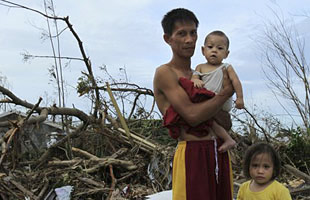WHO responding to health needs caused by Typhoon Haiyan (“Yolanda”)
Supporting Philippine Government with arrival of medical supplies
12 November 2013 — Field hospitals, medical personnel, medicines and other medical supplies are arriving in the Philippines as countries and nongovernmental organizations around the world come to the support of the Philippines in the wake of Typhoon Haiyan. WHO is coordinating all health-related aspects of the emergency response to ensure the supplies are moved quickly to where health facilities and supplies are most damaged.
AP Photo/W. Santana
News release
11 NOVEMBER 2013 | MANILA, PHILIPPINES – WHO has activated an organization-wide mobilization to work closely with the Department of Health, Philippines (DoH) to organize relief efforts for the survivors of Typhoon Haiyan.
The typhoon – locally known as Yolanda – ravaged the central part of the archipelago Friday morning with winds reaching speeds of more than 250 km per hour causing storm surges of up to 5 metres. Many people living in these affected areas were injured and the devastating effects of this typhoon left already vulnerable health facilities damaged or completely destroyed. As a result of the breadth and severity of the storm, health services in the worst affected areas no longer exist or are severely stretched, with medical supplies in very short supply.
“We are working closely with the Philippine Government and local authorities to assess and rapidly address the life-saving needs of the people affected by this typhoon,” says Dr Julie Hall, WHO Representative to the Philippines. “WHO has an assessment team on the ground in Bohol, and we are sending teams to Cebu and Tacloban with the United Nations Disaster Assessment and Coordination (UNDAC) teams in support of national response efforts. WHO is flying in more than two dozen health emergency relief experts and emergency health kits for the initial response.”
The Government estimates that some 4.5 million people have been affected in the Central Philippines. WHO is mobilizing supplies to assist the Government in providing a coordinated, effective and rapid response:
- An initial shipment of four emergency kits with medicines and supplies to cover basic health needs of 120 000 persons during one month and supplies to perform 400 surgical interventions are being deployed. Four diarrhoeal disease kits with medicines and supplies to treat 3000 cases of acute diarrhoea are also being sent.
- WHO is also supporting the Department of Health (DoH) in strengthening its early warning alert and response network (EWARN) to rapidly detect disease outbreaks and other public health threats related to food and environmental hazards.
- The Government is receiving international assistance such as field hospitals and medical teams, and WHO is working closely with the Government to ensure those supplies and teams go where they are needed most.
- Medical storage spaces have also been damaged, and WHO is working to re-establish logistics bases for new supplies that are arriving.
In the aftermath of the typhoon, reaching the affected areas and people has proven to be a sizeable logistical challenge. The true extent of the death and destruction has yet to be quantified. The super typhoon ripped roofs off houses and uprooted trees, interrupting telecommunications and electricity supplies. Many air- and sea-ports in the affected areas are closed. Until roads are cleared, movement will be difficult in these areas, posing significant logistical challenges to emergency relief operations.
Adding to the complexity of this response, another tropical storm is expected to hit the Philippines later this week. Foreign governments and international aid agencies have already pledged support in the form of air transportation and equipment, but more help is urgently needed to save the lives of the survivors.
WHO’s rapid deployment of health experts and supplies to the Philippines has been possible thanks to the financial support for surge capacity provided by numerous international partners, including the European Commission. Due to the magnitude of the disaster, WHO is seeking immediate financial contributions to cover initial response operations. A joint appeal by United Nations and non-governmental organizations will be issued in the coming days.
For more information, or for an interview with Dr Julie Hall, WHO Representative, please contact:
Ms Christine “Tiffany” Domingo-Cool
Event Response operations/Risk communications
Telephone: +639 15 710 4361
E-mail: domingoc@wpro.who.int
Christy Feig
Director of Communications
Telephone: +41 79 251 7055
E-mail: feigc@who.int
Gregory Härtl
Coordinator, News and Social Media
Telephone: +41 79 203 6715
E-mail: hartlg@who.int



